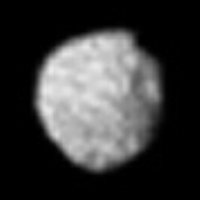 | |
| Discovery | |
|---|---|
| Discovered by | Stephen P. Synnott / Voyager 2 |
| Discovery date | December 30, 1985 |
| Mean orbit radius | 86,004.444 ± 0.064 km[1] |
| Eccentricity | 0.00012 ± 0.000061[1] |
| Orbital period | 0.76183287 ± 0.000000014 d[1] |
| Inclination | 0.31921 ± 0.021° (to Uranus' equator)[1] |
| Satellite of | Uranus |
| Physical characteristics | |
| Mean radius | 81 ± 2 km[2] |
| Surface area | ~82,400 km²[3] |
| Volume | ~2,225,000 km³[3] |
| Mass | ~2.9 × 1018 kg[3] |
| Mean density | ~1.3 g/cm³ (assumed) |
| Equatorial surface gravity | 0.028 m/s2[3] |
| Escape velocity | 0.069 km/s [3] |
| Rotation period | synchronous[2] |
| Axial tilt | zero[2] |
| Albedo | 0.11 ± 0.015 (geometric) 0.035 ± 0.006 (bond) at 0.55 μm[4] |
| Temperature | ~64 K[3] |
| Apparent magnitude | 20.5 [5] |
| | |
Puck (pronounced /ˈpʌk/ puk) is an inner moon of Uranus. It was discovered in December 1985 by the Voyager 2 spacecraft.[6] The name Puck comes from Celtic mythology and English folklore. The orbit of Puck lies between the rings of Uranus and the first of Uranus' large moons, Miranda. Puck is approximately spherical in shape and has diameter of about 162 km.[2] It has a dark heavily cratered surface, which shows spectral signs of water ice.[7]
Discovery and naming
Puck—the largest inner moon of Uranus—was discovered from the images taken by Voyager 2 on 30 December 1985. It was given the temporary designation S/1985 U 1.[8]
The moon was later named after the Puck who appears in Shakespeare's A Midsummer Night's Dream, like a little sprite who travels around the globe at night with the fairies. In Celtic mythology and English folklore, a Puck is a mischievous sprite, imagined as an evil demon by Christians. It is also designated Uranus XV.[9]
Physical characteristics
Puck is the largest of small inner moons of Uranus, which orbit inside the orbit of Miranda. It is intermediate in size between Portia (the second largest inner moon) and Miranda (the smallest of the five large classical moons). Puck's orbit is located between the rings of Uranus and Miranda. Little is known about Puck aside from its orbit,[1] radius of about 81 km,[2] and geometric albedo in the visible light of approximately 0.11.[4]
Of the moons discovered by the Voyager 2 imaging team, only Puck was discovered early enough that the probe could be programmed to image it in some detail.[6] Images showed that Puck has a shape of a slightly prolate spheroid (ratio between axises is 0.97 ± 0.04).[2] Its surface is heavily cratered[5] and is grey in color.[2] There are three named craters on the surface of Puck, the largest being about 45 km in diameter.[6] Observations with Hubble Space Telescope and large terrestrial telescopes found water ice absorption features in the spectrum of Puck.[4][7]
Nothing is known about the internal structure of Puck. It likely is made of a mixture of water ice with the dark material similar to that found in the rings.[7] This dark material is probably made of rocks or radiation processed organics. The absence of craters with bright rays implies that Puck is not differentiated meaning that ice and non-ice components have not separated from each other forming a core and mantle.[6]

0 comments:
Post a Comment